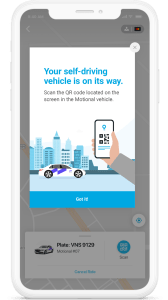Motional, the Hyundai-Aptiv joint venture, and on-demand shuttle startup Via plan to launch a shared robotaxi service for the public in a U.S. city in the first half of 2021. The companies said the aim is to develop a “blueprint” for on-demand shared robotaxis and learn how these driverless vehicles can be integrated into mass transit.
The details on this partnership and the service are scant — at least for now. The companies, which said more specifics would be shared at a later date, didn’t identify the city, provide information on the geographic scope of the service or number or type of vehicles that would be used. The companies did say that the service will be launched in one of the U.S. cities where Motional already operates, narrowing down the possible list to Boston, Pittsburgh, Las Vegas and Santa Monica.
Under the partnership, Motional’s autonomous vehicles will be connected with Via’s platform, which handles booking, routing, passenger and vehicle assignment and identification, customer experience and fleet management. The partnership is similar to the arrangement that Motional has with Lyft in Las Vegas.
This shouldn’t be considered a “driverless” service just yet. All of the autonomous vehicles will have a human safety operator behind the wheel. The service will, however, charge users a fee, indicating that the companies are attempting to home in on all of the aspects that go into operating a commercially viable business. riders will access the robotaxi service through the Via platform and is open to the public. Users won’t be vetted in advanced nor do they have to sign non-disclosure agreements, a practice used by Waymo in its early rider program.
The pursuit of a commercial-scale on-demand shared robotaxis service that is part of a transit network is riddled with hurdles. Vehicles have to be on-demand, optimally routed, and shared by multiple passengers, the companies said. The COVID-19 pandemic has added another layer of complexity — and even opportunity, according to Motional President and CEO Karl Iagnemma.
“This partnership comes at an especially significant moment, as COVID reshapes our views on transportation and consumers demand more, flexible, and varied options,” Iagnemma noted in the announcement, pointing to recent research by Motional that found 70% of Americans who were surveyed said the risk of infection impacts their transportation choices, and one-in-five are more interested in self-driving vehicles than they were before the pandemic.
Via and Motional said the service will take a number of security measures such as partitions, personal protective equipment like masks, frequent sanitizing, contact tracing to ensure the health and safety of vehicle occupants.
Via already has some experience testing and demonstrating how its platform can be used to hail autonomous vehicles. Last October, Via, Hyundai and Chinese AV company Pony.ai partnered to offer a BotRide service in Irvine, California. The service used a fleet of electric, autonomous Hyundai Kona crossovers — equipped with a self-driving system from Pony.ai and Via’s ride-hailing platform. Via has also conducted demonstrations with Navya and Aurrigo, and in its “BusBot” AV service in New South Wales, Australia.
from TechCrunch https://ift.tt/3mukRdC
via IFTTT

Comments
Post a Comment